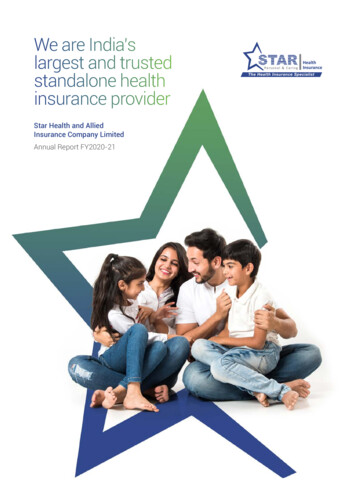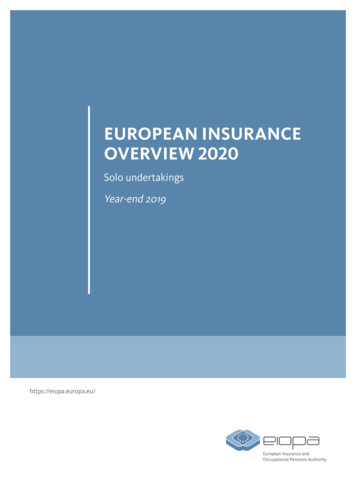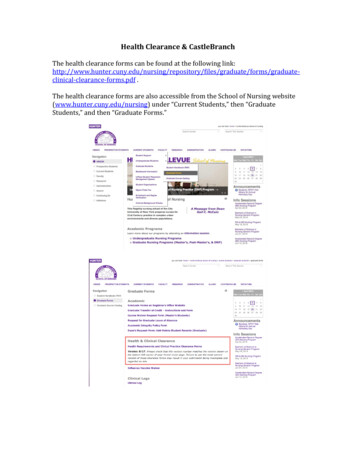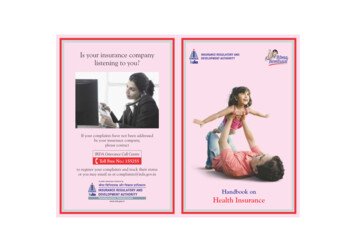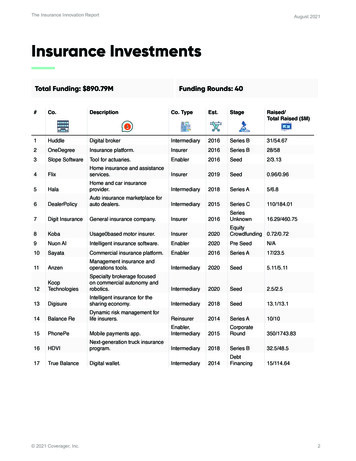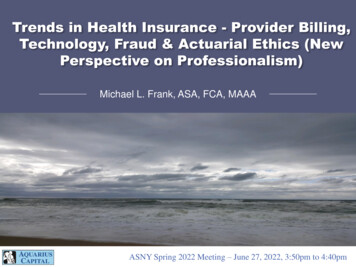
Transcription
Trends in Health Insurance - Provider Billing,Technology, Fraud & Actuarial Ethics (NewPerspective on Professionalism)Michael L. Frank, ASA, FCA, MAAAASNY Spring 2022 Meeting – June 27, 2022, 3:50pm to 4:40pm
Biography of Michael L. FrankPresident & Actuary, Aquarius CapitalActuarial and insurance/reinsurance consulting firm for US and International OrganizationsServed as Adjunct Professor, Columbia University, M.S., Actuarial ScienceGlobal Perspective of Health Insurance Market – Studies systems of US and 24 other countriesEmployee Benefits, Retiree Health Valuations, Provider Contracting & Insurance/ReinsuranceExperience: Insurance/Reinsurance/Employee Benefits (30 Years of Experience)Appointed Actuary: Insurance Companies, HMOs, & ReinsurersConsulted more than 500 municipalities & 100 private equity/hedge fundsHealthcare Provider & Managed Care Carve-Out ConsultingConsult other organizations serving the insurance industry (regulators, accounting firms, brokers, universities)Expert WitnessPrior Employment: Prudential, Coopers & Lybrand, The Segal Company, Physicians Health Services, CoordinatedCare Solutions/Careguide, Transamerica Reinsurance/MFC ReServed as President, Actuarial Society of Greater New York (ASNY) and previously Chairperson for Continuing EducationVarious Actuarial, Insurance, Reinsurance and Healthcare Reform CommitteesRegular Industry Guest Speaker and Publisher of ArticlesInterviewed on Healthcare Billing Practices (e.g., ProPublica/National Public Radio, Wall Street Journal, NBC, etc.)Society of Actuaries LEARN Program – Instructor, Reinsurance for Insurance Regulators (e.g., NYSDFS December 2017)Other Credentials & DesignationsAssociate Society of Actuaries, Member American Academy of Actuaries, Fellow Conference of Consulting Actuaries,International Actuarial Association, Caribbean Actuarial AssociationLicensed life, accident & health broker and reinsurance intermediaryBoard of Directors, Capstone Healthcare Econometrics Research FoundationAdvisory Board, University of Michigan, Actuarial DepartmentVisit www.aquariuscapital.com for full bio2
Presentation DisclaimerThe material contained in this presentation has been prepared solely forinformational and educational purposes. The material is based on sources believed tobe reliable and/or from proprietary data, but we do not represent as to its accuracy orits completeness. We are not providing any compliance, contracting, clinical, legal ortax advise as part of this presentation. The content of this presentation is intended toprovide a general guide to the subject matter with the sole purpose of providing ageneral understanding on the healthcare and insurance industry. Specialist adviceshould be sought about your specific circumstances. This document and its contentsare proprietary. Neither this document nor its contents may be copied or reproducedin any manner without the express consent of the presenter of this program. Thepresenter is not assuming any liability for the content of this presentation. Anyrequests or questions about this material should be forwarded tocompliance@aquariuscapital.com. Contact information for the presenter is providedat the end of the presentation.3
Overview Recent Trends with Insurers and Healthcare Providers Identify Areas of Excessive Billing and Fraud Impact on the Healthcare Professional and Insurance Industry Impact on Consumer Rights Sample Cases and Considerations on Actuarial Professionalism4
Health Insurance “Food Chain” – Employer Model Traditional health insurance arrangement withmedical provided by the member’s employer. The TPA is responsible for processing claims tothe healthcare provider (e.g., physician, hospital,radiology, lab, etc.) and PBM for pharmacy Each may be responsible to provide informationin order for the employer to be reimbursed for aspecific or aggregate claim.Require proof of eligibility, covered services/plansummary, and copies of adjudicated claims andspecific medical management pre-certifications.May be multiple party signoffs(reinsurers/retrocessionaires) or “lead” reinsurersignoff for more complex, high-cost andcatastrophic medical claims.Many of these organizations have investorsbehind them. Definitions: HMO (Health MaintenanceOrganization-a health insurance company), TPA(Third Party Administrator managing claims andeligibility), MGU (Managing GeneralUnderwriter)RetrocessionaireReinsurerReins. BrokerCarrier/HMOProvidersVendor(s)TPA & PBMBroker/ConsultantEmployer5
Sample Provider Reimbursement MethodsPhysicians– Resource-based relative value scale (RBRVS) Fee Schedule– Procedure Code: CPT (Current Procedural Terminology) code or HCPCS (Health CareCommon Procedure Coding System) Sample CPT Codes - Primary Care Visits (e.g., code 992XX) Ears Nose Throat (ENT): Code 31231-Diagnostic Exam of Nasal Passages Using a Scope– Withholds– CapitationCPT CodeDescription of Code9920331231Office Visit or Other Non-Hospital Visit with a ProviderDiagnostic Exam of Nasal Passages Using a kDiscountAmountAfterDiscount% Discount 330.00651.00 79.14273.27 250.86377.7324.0%42.0% 981.00 352.41 628.5935.9%– Inpatient: Diagnostic Related Groups (DRGs)/Case Rates or Per Diems Reimbursements impacted by hospital re-admissions (e.g., Medicare)– Outpatient: ASC (Ambulatory Surgical Codes)Pharmacy– Discounts off average wholesale price (AWP), manufacturer rebates6
Minimum Permissible Loss RatiosMinimum Permissible Medical Loss Ratios 85% large group 80% small groups/individuals Established nationally (federal law)o Variations by states (e.g., New York is 82% instead of 80%)Formula for Medical Loss Ratio Calculation:(Claims Loss Adjustment Expenses Activities to Improve Health Care)(Earned Premium – State Fees)7
Minimum Permissible Loss Ratios (Continued)Impact:Encourages insurance companies to lower administrative costs Potential Impact No.1: Insurers employ less personnel (e.g., claims dept., etc.) toreview claims and rely on artificial intelligence (AI) to manage claims May potentially be less aggressive in claims management due to the rebatetriggering Potential Impact No.2: Insurers pay claims faster to healthcare providers Encourage increase claims volume processed w/ higher “first pass rate” withouthuman intervention (Electronic Data Interchange). Many provider contracts have fast turnaround requirements for claimsreimbursement (e.g., 80% paid within ten days) Third party administrator (TPA) contracts may also have service guaranteesto ensure fast turnaround times Impact of COVID-related claims has impacted “first pass rate”Rebates driven by loss ratio pools Rebates would be returned by insurance companies to policyholders if loss ratiosfall below the minimum permissible levels Will reversing claims trigger potential policyholder rebates based on the formula?8
Components of Healthcare Trend Components: Price Inflation (e.g., fee schedules) Utilization Deductible Leveraging Technological Advances Malpractice Claims Cost Shifting Aging Impact of COVID-19 on the above Fraud: How much of the above costs are due to fraudand excessive billing?9
Ten Common Healthcare Provider Fraud Schemes(Association of Certified Fraud Examiners, 2013) Billing for services not renderedBilling for a non-covered service as a covered serviceMisrepresenting dates of serviceMisrepresenting locations of serviceMisrepresenting provider of serviceWaiving of deductibles and/or co-paymentsIncorrect reporting of diagnoses or procedures (includes unbundling)Overutilization of servicesCorruption (kickbacks and bribery)False or unnecessary issuance of prescription drugsNote: Excluded above is identity theft, which is a growing problem.10
Excessive Healthcare Provider Bills in the News (4 Examples)Sample #1: A Texas hospital that charged a teacher 108,951 for care after a 2017 heartattack told the patient Thursday it would slash the bill to 332.29. This is after insurancepaid the hospital nearly 56,000 for his four-day hospitalization and the procedures toclear his blocked artery. (Source: National Public Radio, 2018)Sample #2: Oklahoma patient gets bill for 15,076 for 4 Tiny Screws. Total bill was 115,527 for a three-day hospital stay, including 15,076 for four tiny screws. (NationalPublic Radio, 2018)Sample #3: Individual has three-hour neck surgery in New York City for herniated disksand received significant bills from 56,000 from hospital, 4,300 from theanesthesiologist and 133,000 from his orthopedist. Individual then receives 117,000from an “assistant surgeon” that individual never met. (Source: NYTimes, 2014)Sample #4: NY Post highlighting a 1 billion scam with one patient highlighted in thearticle receiving more than 1.2 million in hospital bills, including out of network claimsand balance billing. (Source: NY Post, 2018)11
Sample #5: Hospital Bill: Large Claim for Discussion (2015)Patient had one-night hospital stay for partial hip replacement (resurfacing) at NYU-Langone Admit Day: Friday, December 11, 2015 Discharge Day: Saturday, December 12, 2015 2 Hour Procedure: Billed Charges: 138,000 ; Approved Charges: 76,000 All services were billed as in-network and services were pre-authorized. Patient Coverage: 4,000 deductible, 10% coinsurance, 12,000 out of pocket limit. Small group fully insured policyPatient disputed bills with hospital and insurance company for multiple reasons: Specific services identified as not provided (6 PT/OT visits, infusion drugs); Specific services identified upcoded (10 of 11 items inappropriately billed asimplantable devices); Bill had visible errors (e.g., services listed had names of other patients on it, bills hadincorrect services coded, etc.); Bills were not transparent (e.g., no units, etc.) and appeared very excessive.12
Hospital In-Network Bill – Partial Hip Replacement(Resurfacing) for One Day Hospital StayHospital Billed Amounts for One Day Length of Stay (December 2015)1234567891011121314151617181920Hospital Service Category0121-MED-SURG-GY/2 BED0270-MED-SUR SUPPLIES0272-STERILE B/CHEMISTRY0305-LAB/HEMATOLOGY0320-DX X-RAY0360-OR SERVICES0370-ANESTHESIA0420-PHYSICAL THERP0424-PHYS THERP/EVAL0434-OCCUP THERP/EVAL0636-DRUGS DETAIL CODE0710-RECOVERY ROOMPrivate Duty RoomSurgeon (Hospital Employee)Anesthesiology (Hospital Employee)Lab (Hospital Lab)GRAND TOTALHospitalReported Units121111511111704113951Not AvailableNot AvailableNot AvailableNot Available606 HMO Adjudicated Claims and Calculation of Member CostHospitalBilled .86HMOPaid Claims 33,944.01Part of Case RatePart of Case Rate 25,721.41 2,478.78Part of Case RatePart of Case RatePart of Case RatePart of Case RatePart of Case RatePart of Case RatePart of Case RatePart of Case Rate 1,649.99Part of Case Rate 2,305.84 1,930.50 68,030.53Patient BilledAmount (Cost) 3,771.56Part of Case RatePart of Case Rate 2,857.93 275.42Part of Case RatePart of Case RatePart of Case RatePart of Case RatePart of Case RatePart of Case RatePart of Case RatePart of Case Rate 183.33Part of Case Rate 390.00 256.21 214.50 122.50 8,071.45HMO Approved Payment Amount as a % of Billed Charges HMO % Discount off of Billed Charges HospitalApproved Payment 37,715.57Part of Case RatePart of Case Rate 28,579.34 2,754.20Part of Case RatePart of Case RatePart of Case RatePart of Case RatePart of Case RatePart of Case RatePart of Case RatePart of Case Rate 1,833.32Part of Case Rate 390.00 2,562.05 2,145.00 122.50 76,101.9854.8%45.2%Note: Costs for a one-day length of day. Excludes pre-op expenses and DME costs, plus invoices that included services for other patients.Question: Why is the case rate higher than its associatedbilled charges? 9% higher (28% higher excluding lines 11-13)13
Sample #5 Hospital Bill (Rev Code 278) - Implantable Device Cost for HipSurgery Adjudicated by Insurer (December 11, 2015 Procedure)1LineNo.1234567891011DescriptionSUT FIBER WIRE BRD BLU W/NDL NO 2SUT FIBER WIRE BRD BLU W/NDL NO 2SUT FIBER WIRE BRD BLU W/NDL NO 2SUT FIBER WIRE BRD BLU W/NDL NO 2SUT FIBER WIRE BRD BLU W/NDL NO 2MIXER CEMENT BONE EVAC IIIDRILL BIT QC STER 3.2*145MMCEMENT BONE SIMPLEX RADIOPAQUETISSEL FROZEN 10 ML*IMPACTOR BHR 54MM*HEAD BHR 48 MM2ImplantableDeviceUnits1111111111112 Subtotal1134NYU-LangoneHospitalBilled Charges 173.90 173.90 173.90 173.90 173.90 531.66 874.20 957.30 4,290.82 28,697.45 34,235.55Insurance CompanyApprovedCost as ImplantableDevice at 2,600per Device Rate 2,600.00 2,600.00 2,600.00 2,600.00 2,600.00 2,600.00 2,600.00 2,600.00 2,600.00 2,600.00 2,600.00 70,456.48 13 Insurance Company Explanation of Benefits Calculated Discount1 - [ Column (4), Line (12) ] / [ Column (3), Line (12) ]14 Ratio of Total to Amount Paid (True Cost) by Hospital (Hospital Markup)(12) / 1,500*Note :56 2,340.002,860.00 25,740.00Member CostShare @ 10% 260.00 260.00 260.00 260.00 260.00 260.00 260.00 260.00 260.00 260.00 260.0028,600.00 59.4% off billed charges4697%1907%191%1716%Per Hospital staff and the manufacturer, lines 10 and 11 cost Hospital less than 1,500 combined and hospital also received rebates for the device.Hospital bill charges to the consumer is 62,933.00 for lines 10 and 11 combined.Visit tterRecentDevelopmentsInHealthCareJul19.pdf14
Top 10 Medical Device Technologies Market worthabove 400 Billion by 2020(Source: MarketsandMarkets, November 15, 2018) The global top 10 medical device technologies market is fragmented in nature. Prominent players in this market include:– Johnson & Johnson (U.S.), GE Healthcare (U.K.), Siemens Healthcare (Germany), Medtronic(U.S.), Philips Healthcare (Netherlands), Roche Diagnostics (Switzerland), Abbott LaboratoriesInc. (U.S.), Smith & Nephew plc (U.K.), Stryker Corporation (U.S.), Boston Scientific Corporation(U.S.). The growth in the top 10 medical devices industry is mainly driven by the risingprevalence of chronic lifestyle diseases like cardiovascular, diabetes, hypertension,cancer, and respiratory problems. Similarly, the rising acceptance of newer technologies by physicians & hospitals andgrowing geriatric population are also driving the overall growth of the top 10 medicaldevices market. However, factors such as uncertainty in reimbursement and the imposition of the medicaldevice excise tax in the U.S. are restraining the growth of this market.15
Sample Emergency Room Visit (2021)Description of Service1 Dress/Debrid P-Thick Burn M (16025)2 Emergency Dept Visit (99283-25)3 Unclassified Drugs (J3490)4 Dress/Debrid P-Thick Burn M (16025)5 Emergency Dept Visit (99283-25)6 Subtotal: (1) (5)Adjustment CodePPO008DED003, PPO008PPO008PPO008PPO0087 Reported Discount by Insurance Company in EOB8 Remove Duplicates: (1) (2) (3)9 Reported Discount by Insurance Company if Removing DuplicatesHospitalBilled 563.23 1,479.99 0.70 544.23 698.87 3,287.02InsuranceApproved 2,632.00 2,632.00 PlanPaid-MemberResponsibility 2,632.00 2,632.00MemberObservationBacitracinDuplicate of Line 1Duplicate of Line 219.9% Discount off Billed Charges 2,043.92 2,632.0028.8% Load off Billed ChargesNotes:A. Two Hour Emergency Room Visit with less than 10 minute visitB. Adjustment Code PPO008 means provider accepted "contracted rates" and DED003 means applied to members deductibleC. EOB talks about surprise bill laws for out of network claims. This claim was in-network.16
You be the “Judge” on Fraud (Samples) Primary Care Visits (e.g., code 992XX) billed at higher intensive and more expensivecode than the service actually providedSpecialty Services billed additional services (samples) Pulmonary: Code 94060-Respiratory Test Measuring Air Speed w Medicine Cardiology: Code 93015-Stress test with additional physician office charge ENT: Code 31231-Diagnostic Exam of Nasal Passages Using a ScopeHospitalization: Sample Procedures with Billing Abuses: Infusion, Implantable Supplies,Rehabilitation (Physical Therapy/Occupational Therapy)Durable Medical Equipment:– Is equipment being used? Medically necessary? Kickbacks to Providers?Home Care: Providing services to individuals that don’t meet the requirements to getcare.Lab and Blood Work Bills greater than 2,000 that are considered paid in full for less than 50. Potential impacts of physicians referring to labs that they have ownership in.17
Sample ENT Office Visit (5 Minutes)Summary of Costs before Application of Member Cost SharingCPT Code Description of CodeAmountBilled Insurance AfterCharges Discount Discount % Discount9920331231 330.00 79.14 250.86 651.00 273.27 377.7324.0%42.0% 981.00 352.41 628.5935.9%SubtotalOffice Visit or Other Non-Hospital Visit with a ProviderDiagnostic Exam of Nasal Passages Using a ScopeNote : Healthcare provider is a large Accountable Care Organization in Rye, NY (Zip Code 10580). Bill was mailed from Boston, MA address.Fraud increased the cost from 250.86 to 628.59, or 377.73 (or 150.6% increase)18
Adverse Impact on ConsumersBusiness Insider (3/10/22) The Kaiser Family Foundation found 3 million Americans owe over 10,000 in medical debt. It estimated total medical debt in the US is 195 billion, and it unevenly falls on patients ofcolor. The debt can cause patients to skip needed doctor's visits, along with hurting credit reports.Kaiser Family Foundation (1/5/2016) Four out of 10 Americans (actually 37%) say they are saddled with active debt from medicaland dental polls, according to a new KFF Health Care Debt Survey. Among the Insured with Medical Bill Problems, 63% Report Using Up Most or All TheirSavings and 42% Took on an Extra Job or Worked More Hours Half of People Without Health Insurance Report Problems With Medical Bills, and They FaceSimilar Financial and Personal Consequences As Those With Insurance Among people with health insurance, one in five (20%) working-age Americans reporthaving problems paying medical bills in the past year that often cause serious financialchallenges and changes in employment and lifestyle, finds a comprehensive new KaiserFamily Foundation/New York Times survey. As expected, the situation is even worse among people who are uninsured: half (53%) faceproblems with medical bills, bringing the overall total to 26 percent.19
False Claims Act Referred to as the “Lincoln” Law (1863) Criteria Services not rendered; Services performed on non-existing or phantom patients; Upcoding: Procedures more expensive than those actually performed(“up-coding” or “code creep”); Unbundling: Itemizing billing services that should be bundled (e.g.,Medicare); Non-medically necessary services being performed; Individuals can be prosecuted for violating this (e.g., Department of Justice,State Government) “Qui Tam” Action: Private individuals known as “relators” could pursue this remedy througha “qui tam” action “Whistleblowers” are also entitled to financial remedyShould the False Claims Act apply to all members of all plans?20
Other Laws Regarding Fraud & Excessive Billing 1872 (Approximately): Mail Fraud Laws 1914 (and Updated 1938): The Federal Trade Commission Act to prohibitunfair/deceptive acts and practices in commerce. 1970: Racketeer Influenced and Corrupt Organizations (RICO) Act of theOrganized Crime Control Act 1995: Stark Act prohibited physicians from referring Medicare/Medicaid patientsto providers (initially labs) that the physician owned or had a family member. 2015 (NY): Protection from Surprise Bills and Emergency Services Protects consumers from surprise bills when services are performed by a non-participating (outof-network) doctor at a participating hospital or ambulatory surgical center in your HMO orinsurer's network or when a participating doctor refers an insured to a non-participating provider. The new law also protects all consumers from bills for emergency services. Law only addresses out of network claims, not excessive or fraudulent billing for in-networkclaims.21
Improper Medicare Payments Hit Lowest Level in Nearly aDecade (Source: Modern Healthcare 11/16/18) More targeted enforcement actions by CMS has led to the lowest improperpayment rate for Medicare in nearly a decade, according to new federal data. The CMS doled out an estimated 31 billion in improper payments in fiscal 2018,which is around 8.12% of all claims paid during that period, according to a reportissued Friday.o That's down from 36.2 billion or 9.51% of Medicare claims in fiscal 2017. Improper payments include fraudulent claims, payments distributed to the wrongrecipient or for the wrong amount, payments with insufficient documentation, andthose when the recipient uses the funds improperly. The CMS calculations include all claims incorrectly paid between July 1, 2016, andJune 30, 2017. This is the lowest rate of improper payments for Medicare fee-forservice since 2010 and the second time since 2013 that the rate fell below 10%.Question:How many more fraud claims would be filed and reported if membershad material cost sharing (e.g., no Medicare supplement policy, etc.)?22
Provider Collection Process With members having higher cost sharing (e.g., larger deductibles,higher coinsurance, etc.), healthcare providers have had to increasetheir collections process. Multiple Collection Agencies – Internal (subsidiary) vs. Third Party Unbundling Bills with Each Procedure Code being a DifferentCollection Letter or Organization Filing Claims in Court without Due Process or Notification (e.g.,people sued without receiving a subpoena, etc.) Certain types of claims are triaged to the Bad Debt Pool 1983: New York established a Hospital Bad Debt and Charity Care Pool forhospital losses associated with uncompensated care. Renamed the HospitalIndigent Care Pool (1997) Became a series of subpools initially funded by payer add-ons to regulatedinpatient hospital rates and an assessment on hospital inpatient revenues.23
What is the New York State Bad Debt/Indigent Pool?1996: Health Care Reform Act (HCRA) replaced these inpatient payer add-ons with a morecomprehensive system of payer surcharges on both inpatient and outpatient hospital servicesIndigent care awards reflect write offs of bad debt and charity care. Each hospital’s amounts are currently reported in the aggregate based on hospital charges.Not tied back to a related rendered service or to a patient, much less a patient’s insurance orincome status.2018: Community Service Society (CSS) reports that the indigent care pool continues to providewindfalls to non-safety net hospital. (Source: www.cssny.org) Delay in full implementation of reforms to the allocation of scarce Indigent Care Pool (ICP)funding have resulted in unintended consequences.A new Community Service Society study of New York’s ICP found that hundreds of millions ofdollars actually flowed away from struggling safety-net hospitals serving large numbers ofuninsured and low-income patients to hospitals with healthier bottom lines.Question #1: What percentage of submitted claims to the indigent pool are fraudulent?Question #2: Are billed charges high so that hospitals can capture more dollars from the state indigentpool?Question #3: What is the reporting and auditing requirements of these pools?24
How does the Law and Insurance Apply? “Account Stated” When a provider sends a bill, you are obligated to object in writing withina reasonable time if you are to dispute or believe in error (e.g., 30 days). When a provider refers you to an insurance company, then is the providerwaiving their rights to enforce this requirement? It is not consistent with the appeals process for medical plans (fullyinsured or self-funded). Sample Fully Insured Claim Denial Language “If you do not agree with the final decision, you have the right to bringcivil action under Section 502(a) of ERISA within two years of thedecision.” Does this mean federal laws trump state laws for insurance disputes? 1945: McCarran–Ferguson Act, a federal law exempted the businessof insurance from most federal regulation, so states becameresponsible for regulating insurance.25
Special Investigations Unit (SIU) Target health care-related fraud and abuse, including internal fraud, electronictransaction fraud and external fraud.o Sample Brochure of a Sample SIU - http://www.aetna.com/data/fraud2.pdfo Sample Services Unusual provider billing practices.Discrepancy between the submitted diagnosis and the treatment.Diagnoses or treatments that are outside the practitioner’s scope of practice.Many other fraud related items.Potential Issues – Is the Insurance Industry Enabling Fraud?o One insurance company’s SIU confirmed that it will not share results with themember (the one filing the complaint) nor adjust the adjudicated cost sharing.o How does member know the complaint was reviewed or decided on?o Why would member’s cost sharing not be adjusted if fraud is correctly identified andcodes/services are to be adjusted? Wouldn’t deductibles, copays, coinsurance, out-ofpocket maximum costs change?o Why would SIU withhold pertinent information to a patient (especially one defendingitself in potentially a wrongful litigation) or put up “road-blocks” in the investigationprocess?26
Steps to Increase Fraud Prevention Laws on Transparency – Unfortunately, consumer inability to auditinsurance company-provider contracts. Redesign health insurance plans so individuals have more “skin inthe game” through member cost sharing to provide incentives tovalidate claims.o Unidentified Fraud: Medicare fraud identified is approximately 10% andwould be higher if members had more cost sharing (note cost sharing is lowfor individuals with Medicare and Medicare Supplement policies) Technology to survey individuals to confirm care.o Validate services provided, including duration and healthcare provider nameo May pick up fraud through identify theft Tracking member utilization with providers including volumes andproximity.o Analytics to track utilization patterns of physician and pharmacy dispensing ofdrugs and other services (e.g., physical therapy)o Aggregating data to track patterns and anomalies in datao “Common Sense” analytics27
Code of Professional Conduct(Professional Integrity – Precept 1)PRECEPT 1. An Actuary shall act honestly, with integrity and competence, and in a mannerto fulfill the profession’s responsibility to the public and to uphold the reputation of theactuarial profession. ANNOTATION 1-1. An Actuary shall perform Actuarial Services with skill and care.ANNOTATION 1-2. An Actuary shall not provide Actuarial Services for any Principal if theActuary has reason to believe that such services may be used to violate or evade theLaw or in a manner that would be detrimental to the reputation of the actuarialprofession.ANNOTATION 1-3. An Actuary shall not use a relationship with a third party or with apresent or prospective Principal to attempt to obtain illegal or materially impropertreatment from one such party on behalf of the other party.ANNOTATION 1-4. An Actuary shall not engage in any professional conduct involvingdishonesty, fraud, deceit, or misrepresentation or commit any act that reflectsadversely on the actuarial profession.Source: code of conduct.8 1.pdf
Hypothetical Question #1 on Actuarial EthicsQuestion #1 - Premium Rate Development: Should actuaries assume somelevel of responsibility for including extraordinary amounts of fraudulent claimsin premium rate filings (e.g., Precept 1-”profession’s responsibility to thepublic”)?If claims include fraudulent claims and a target loss ratio for pricing is used, thenthe potential for administrative loads and profit margins to include an additionalamount (“mark up”) for such fraudulent claims.Is the insurance industry preventing or enabling fraud by including the costs offraud in premium rate development (e.g., putting an administrative/retentionload on top of each fraudulent claims dollar)?
Minimum Permissible Loss RatiosMinimum Permissible Medical Loss Ratios 85% large group80% small groups/individualsEstablished nationally (federal law)o Variations by states (e.g., New York is 82% instead of 80%)Formula for Medical Loss Ratio Calculation:(Claims Loss Adjustment Expenses Activities to Improve Health Care)(Earned Premium – State Fees)Question: How much additional premium is received above claims due to the inclusionof fraudulent claims?
Fraud Education & Regulation Member education to recognize the signs of fraud Enforce laws that are currently in existence and prosecutethose committing the crimes.o High profile healthcare providers are not prosecuted or publicized in the news. Regulators should require more transparency and followup by insurance companies receiving complaints of fraud.o Currently consumers do not receive follow ups or results to fraudinvestigations by insurance company fraud units.o Insurance policies currently have little information to assist a covered memberin reporting or identifying fraud. Members generally do not know what to do when a victim of abusive billing or fraud.o Potentially modify loss ratio calculations to make fraud investigation afavorable part of the permissible medical loss ratio calculation.o Have premium rate approval decisions be contingent on insurance companieshaving effective.o Regulators are spending more resources on cybercrime.31
Components of Healthcare Trend Components: Price Inflation (e.g., fee schedules) Utilization Deducti
Sample Cases and Considerations on Actuarial Professionalism 4. . 31231 Diagnostic Exam of Nasal Passages Using a Scope 651.00 273.27 377.73 42.0% Subtotal 981.00 352.41 628.59 35.9%. Minimum Permissible Loss Ratios Minimum Permissible Medical Loss Ratios .

